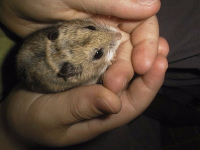 Back
Back
HIBERNATION
IN PETS
First broadcast on www.provet.co.uk |
This information is provided by Provet for educational purposes only.
You should seek the advice of your veterinarian if your pet is ill as only he or she can correctly advise on the diagnosis and recommend the treatment that is most appropriate for your pet.
Hibernation is a natural phenomenon in some animals - but owners often think that their pet has died !
Many small mammals (eg mice, hamsters, hedgehogs, bats) and reptiles (eg tortoises) have evolved the mechanism of hibernation for surviving through the cold winter months when, under natural circumstances, food would be difficult to find. The state of hibernation is triggered by environmental factors such as reduced length of daylight hours, and low temperatures. During hibernation the animals metabolic rate decreases so that body energy reserves (as stored fat) are slowly used up. As part of this process the heart rate, breathing rate and body temperature all fall so much that unsuspecting owners often think that their little pet has died. In hamsters the body temperature can fall to as low as 0o C (32o F) and the heart may only beat once every few minutes.
How do you know if your pet is truly hibernating ? Hibernating animals can be revived by placing them on a warming pad set at 30oC (90oF) for 30-60 minutes. Never attempt to revive hibernating animals in ovens or microwaves !
Because animals that hibernate rely on stored energy reserves to survive they should be well nourished before they hibernate. Also, prolonged periods of hibernation should not be encouraged because animals may burn up all their stored energy reserves and have to use up vital body tissues. This can lead to weakness, inappetance and susceptibility to disease when they do emerge out of hibernation.
Animals kept indoors in warm conditions do not need to hibernate, and animals that do hibernate should be encouraged to come out of it by placing them in a warm environment as soon as the bad winter weather has finished.
Updated October 2013
